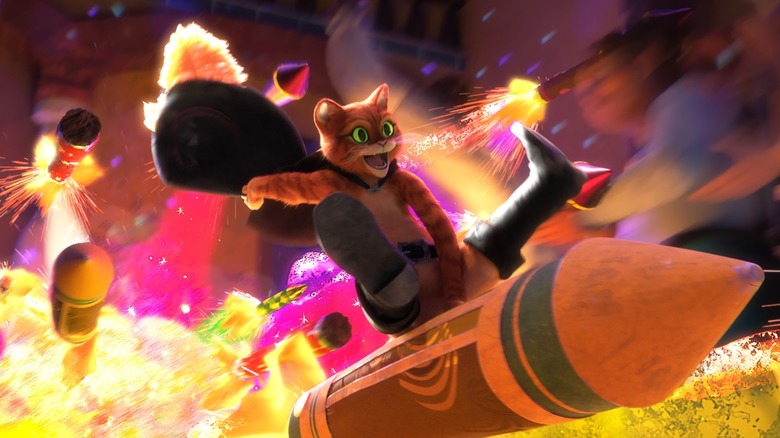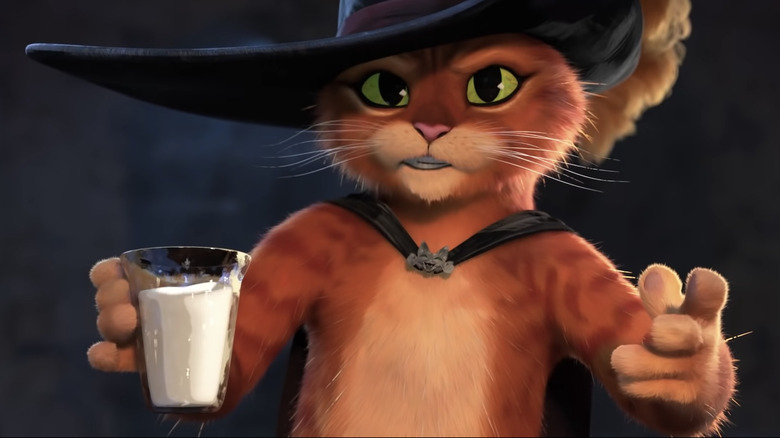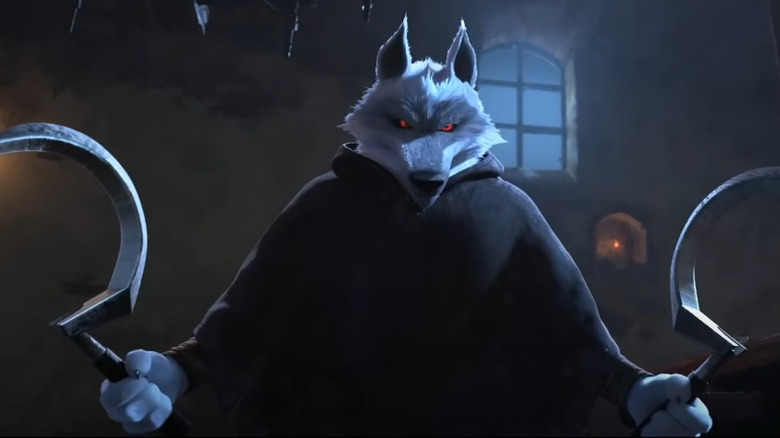Establishing The Stakes Of Puss In Boots: The Last Wish Required A Drop Of Blood [Exclusive]
The overwhelming volume of "Shrek"-related media continues to grow with "Puss in Boots: The Last Wish," the new animated film from director Joel Crawford ("Kung Fu Panda," "The Lego Movie 2: The Next Part"). "The Last Wish" is a sequel to the 2011 "Puss in Boots" feature which, in itself, was a spinoff from "Shrek 2" in 2004. The film's title character — a variation of the character first seen in 16th-century Italian literature — is a stylish, sword-wielding hero voiced with brio by Antonio Banderas. Much of the character's comedic power comes from the fact that, well, he's an anthropomorphic cat who has sword fights with humans six times his size. That is, before he pauses for a hairball.
In "The Last Wish," however, Puss finds himself facing his mortality. Cats have nine lives and, after a moment of reflection, our heroic cat realizes he has finally reached his last one. While drinking away his newfound mortal anxiety in a bar (milk, of course), Puss is approached by a wicked, nameless, red-eyed wolf (Wagner Maura) that aims to kill him. The wolf wears a black cloak and wields a pair of small sickles. Puss, while a capable fighter, is not quite able to fend off the skillful slices of the Big Bad Wolf. The Wolf temporarily spares him, but he will remain a shadowy presence throughout the rest of the film, tailing the be-tailed one, eager to make a final kill.
Prior to that, Mr. PIB sings a folk song about how Puss has never been touched by a blade (his previous deaths were largely foolish accidents). In order for the film to assure Puss' mortality, he has to bleed. /Film's own Rafael Motomayor spoke to Crawford about that moment, and how animating blood, while novel for DreamWorks Animation, was necessary.
It needs to be scarier
Blood is not typically seen in mainstream American animated films, thanks to most studios' use of the medium for children's fare. Films like "The Last Wish" may feature monsters, fights, and even death (villains are often hoisted by their own petards), but one would be hard-pressed to find a cartoon character that bleeds. For Joel Crawford, blood was the ultimate symbol of mortality, falling back on the adage taught to audiences by the font of wisdom that is John McTiernan's 1987 film "Predator," which stated that if something bleeds then it can be killed.
Crawford needed to establish that Puss was not only mortal, but that he was afraid for his (remaining) life. In so doing, he felt he also needed to scare the audience a little. The Wolf couldn't merely be a fighter. It had to be a monster. It had to, in Crawford's words, feel right:
"These movies are kind of like sculpting. You're always adding or taking away and you're just trying to find what feels right. And really, with that one, I approach most things as a comedy because I just love character comedy, but that's my endpoint. For me, it was kind of a discovery of, 'This has to be scarier. I'm not feeling anything here.'"
This led to the ultimate conclusion to, well, slice the kitty:
"We kept going further until we found kind of two key ingredients. Puss is bragging about how he's never been touched by a blade in his opening song. This is kind of the epitome of his arrogant, immortal worldview. To be able to find a way to bring that back in a very poignant way felt like, 'Well, Puss has to bleed here.'"
The Big Bad Wolf
Dealing with a family-friendly animation studio like DreamWorks, however, required Joel Crawford to get creative. All of the "Shrek" movies to date has been rated PG, and the violence rarely extends past some form of fantastical mayhem. The "Shrek" movies are set in a fantasy universe where fairy tale characters can interact. Blood, as one might recall, doesn't often enter into it. Crawford, however, found a clever way, artistically, to depict blood on-screen without giving it any violent, real-world heft. He explained:
"When you're working on a DreamWorks movie, you're going, 'I don't think we've had blood in previous installments of any of these movies,' but that was just one of those things where we're always cognizant of not being literal, but impressionistic. [...] Nate Wragg, the production designer, found this great thing where, by the moment we do this kind of freeze-frame in the air where the Wolf swipes at [Puss], and the whole background goes red."
The red background, then, can evoke blood without actually having it appear on-screen. Then, to drive the point home, Puss' big mirror-like cat eyes could subtly reflect what was really going on. Crawford continued, saying:
"As an audience, you get this wash of red. Then the very next shot is this kind of Sergio Leone closeup of Puss's eyes and the only red in the shot is a drop of blood. That makes the audience impressionistically, they feel the red, and then they zero in on the very next shot, just that coming down."
And that was all it took to establish fear, style, and mortality. A drop of blood, reflected in a cat's eye (which would be a great title for an Italian Giallo film).
"Puss in Boots: The Last Wish" is currently playing in theaters.


